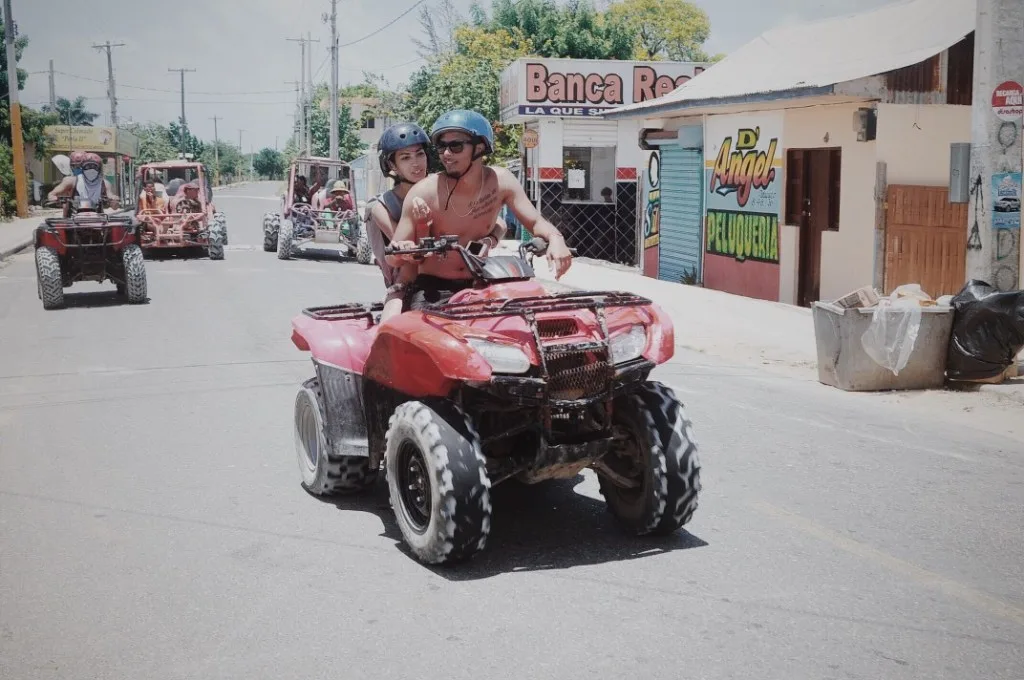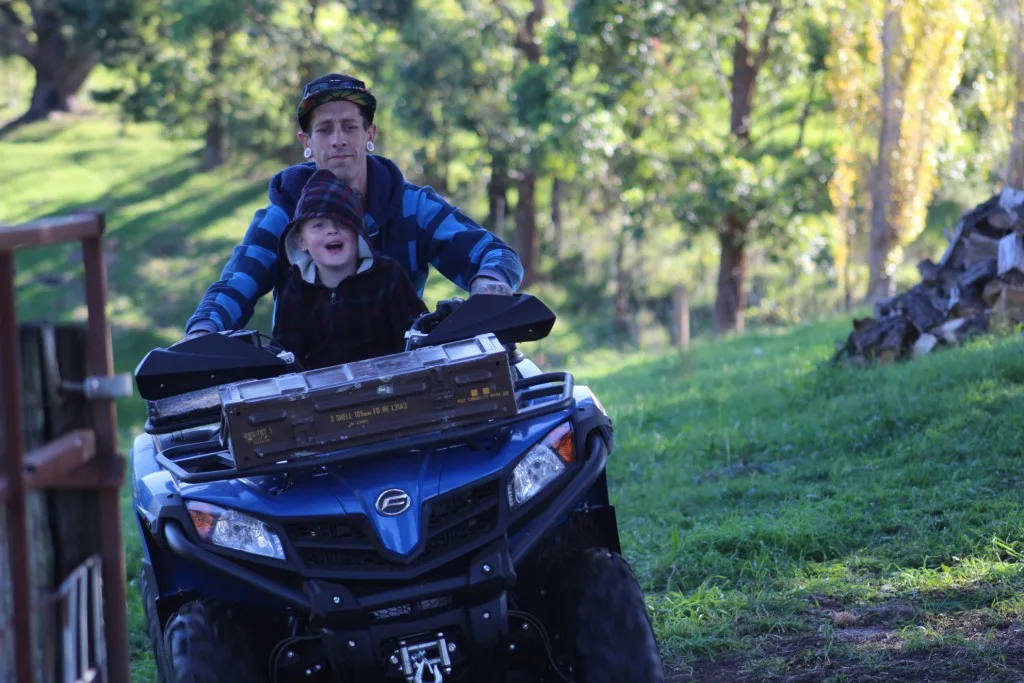When you see someone driving an ATV in a neighborhood, it sticks out. Doesn’t it?
It makes you wonder if it’s even legal or if they’re breaking the law.
It may be surprising, but the answer isn’t as clear as you might think.
Let’s take a look!
What Is an ATV?
An ATV is an open-motor vehicle that has one or two seats and three or more wheels. ATVs typically have larger tires for use on rough terrain.
However, even though this is the more standard definition for ATVs, the real-world definition normally refers to four-wheelers or quads.
Four-wheelers and quads appear the same, but they’re slightly different. A four-wheeler is a more work-related vehicle used on farms, ranches, and other places. People tend to get a quad just for fun and not work.

Do You Need a License to Drive an ATV?
Regulations vary from state to state, and they can get confusing. For example, no one under 18 can operate an ATV on any public land in California, including neighborhoods. There are exemptions if the minor has taken a safety course or possesses a state-issued safety certificate. Alternatively, kids can be under supervision by an adult who possesses a state-issued safety certificate for ATVs.
If the minor is under 14, there’s an additional stipulation. They must meet at least one of the previous requirements, and a parent or guardian must supervise the minor.
You should check with local law enforcement to get the most accurate information for your specific state. All of the previously mentioned information applies to riding an ATV on public lands.
If you’re planning to ride an ATV on private land, you don’t need a license. However, you should still ride safely and responsibly.
Can You Legally Drive an ATV in a Neighborhood?
When it comes to riding an ATV in a neighborhood, the answer can be a bit unclear. This is because there’s not a rule or law that applies to every location. Laws vary from state to state but also city to city. Riding your ATV around a large city will likely result in a confrontation with the police.
However, driving through a rural environment is more common.
Some states have age restrictions for ATV operators when on public roads. Arizona, for example, requires a license plate, horn, proof of liability insurance, and emissions test. Then there’s Delaware, which banned all ATVs from public streets.
You can push your ATV in neutral alongside the road, though.
Pro Tip: Love the feel of the wind in your hair while ATVing? Chase that feeling with these 5 Best Motorcycle Camper Trailers.

Which States Allow ATVs on Neighborhood Roads?
You’ll encounter many restrictions regarding riding an ATV on neighborhood streets. You can usually only do it in emergencies, for agricultural reasons, or if the ATV is street legal.
Here are the states that allow ATVs on neighborhood roads in some capacity:
Alaska, Arizona, Arkansas, California, Colorado, Connecticut, Florida, Hawaii, Idaho, Illinois, Indiana, Iowa, Kansas, Kentucky, Louisiana, Maine, Michigan, Minnesota, Mississippi, Missouri, Montana, Nebraska, New Hampshire, New Mexico, New York, North Carolina, North Dakota, Ohio, Oklahoma, Pennsylvania, South Dakota, Tennessee, Texas, Utah, Vermont, Washington, West Virginia, Wisconsin, and Wyoming.
Although these states may allow ATVs on neighborhood roads in certain circumstances, it’s not all circumstances. Check with your local authorities before attempting to ride your ATV on any neighborhood roads.
Where Can You Drive ATVs?
Riding on public roads can be a nuisance and is often illegal. So, it’s best to stick to ATV trails, private lands, and even off-roading parks. If you’re choosing to ride on private land, you should make sure you have permission.
It’s fun exploring new land on your ATV. But, that can end pretty quickly when you run into an angry landowner or law enforcement.

Is There Such a Thing as a Street-Legal ATV?
Qualifications for street-legal ATVs will vary from state to state. Some states will require a horn, proof of insurance, a license plate, and an emissions test. However, these restrictions vary from state to state, county to county, and town to town.
Pro Tip: If you’re a full time RVer an ATV might not be your first purchase priority, but before you hit the road make sure to stock up on these 101 Must Have RV Accessories.
Can You Drive a Street-Legal ATV in a Neighborhood?
If your ATV is street-legal for where you live, nothing is stopping you from doing so. Being street-legal means your ATV meets all of the requirements necessary to drive on the road.
As the requirements vary from one location to the next, you should check local laws. If you decide to drive on the street and it’s not street-legal, you could get a citation or fine.
The Best Places to Drive an ATV
The best places to drive an ATV (All-Terrain Vehicle) can vary depending on your preferences and the type of riding experience you’re seeking. Here are some popular options:
- Off-Road Parks and Trails: Many regions have designated off-road parks and trail systems that are specifically designed for ATV riding. These areas often offer a variety of terrains, including mud, sand, rocks, and wooded paths, catering to different skill levels.
- National Forests and BLM Lands: In the United States, national forests and Bureau of Land Management (BLM) lands often have designated trails and areas where ATV riding is permitted. These areas can offer diverse landscapes and beautiful scenery.
- Desert Dunes: If you’re into sand dune riding, desert regions like Glamis in California, USA, or the Dubai Desert in the United Arab Emirates are famous for their extensive sand dunes that provide thrilling riding experiences.
- Mountain Trails: Mountainous regions with rugged terrain offer challenging and scenic ATV riding opportunities. Locations like the Rocky Mountains in the United States or the Canadian Rockies provide breathtaking views and exciting trails.
- Beaches: Some beaches, particularly in areas where regulations permit, offer ATV riding along the shoreline. Just make sure to follow any local rules and respect the environment.
- Rural Countryside: Exploring the countryside on ATV can be a great way to enjoy nature, open fields, and small trails. Just be sure to respect private property and obtain permission if needed.
- Motocross and ATV Parks: Specifically designed motocross tracks and ATV parks offer dedicated spaces for more intense riding experiences. These parks often have jumps, berms, and other obstacles for an adrenaline-pumping ride.
- Rock Crawling: If you’re interested in technical challenges, some areas have rock crawling trails that test your ATV’s capabilities on rocky terrain.
- Snow Trails: In snowy regions, some ATVs can be fitted with tracks or skis to ride on snow-covered trails during the winter months.
- Guided Tours: Joining guided ATV tours can be a great way to explore new areas while being led by experienced guides who know the best routes and safety measures.
Remember to always prioritize safety when riding an ATV. Wear appropriate safety gear, follow local regulations and guidelines, ride responsibly, and respect the environment and other trail users. Before heading out to any location, it’s important to check local laws, regulations, and permissions regarding ATV riding.
Tips for ATV Safety
No matter where you’re riding your ATV, we have a few safety reminders for you. Always obey all safety recommendations and suggestions by your ATV’s manufacturer, including age and use restrictions. Also, wear a helmet and drive at safe speeds.
You may feel invincible while flying over a jump or down a trail. But you’ll quickly realize you’re not a superhero if you take a fall. ATVs are heavy and can easily crush you, resulting in broken bones or even death.
Strapping on your helmet and safety gear and flying down a trail or road on an ATV can be a massive adrenaline rush. You might have to drive through a neighborhood to reach those dunes, however, and that’s where legality gets tricky.
Always check your local laws and ordinances before you go flying down Main Street. Do you see people riding ATVs in your neighborhood?
Discover the Best Free Camping Across the USA
To be honest with you, we hate paying for camping. There are so many free campsites in America (with complete privacy).
You should give it a try!
As a matter of fact, these free campsites are yours. Every time you pay federal taxes, you’re contributing to these lands.
Become a FREE CAMPING INSIDER and join the 100,000 campers who love to score the best site!
We’ll send you the 50 Best Free Campsites in the USA (one per state). Access the list by submitting your email below:
This question of driving an ATV in a neighborhood, especially on city streets, sits adjacent the regulations for neighborhood vehicles. California was first, and federal enabling legislation followed. Regulations and tolerance vary, from everything goes to nothing rolls.
California’s initial legislation was nicknamed the “golf cart law” after the first generation. GEM and ZENN cars have followed. This remains a work in progress. My personal heartburn is parents who perch a child on the front of a ATV and crash. This rarely ends well. Bruce Parker ACEP Injury Prevention Committee
I live in Trussville ,Al. Kid in our subdivision rides his 4 wheeler in the street. In his hard they have no grass. Which as he rides the 4 wheeler he causes dust storms.I love across the street from him. I am Allergic to dust Which means I can’t go outside When he’s riding which is everyday.The police do nothing even though he rides on the streets with it as well Please help me.
I believe that permission is ALWAYS required when traversing private land, whether on foot, or with anything motorized. IMHO, to not make that totally clear is not a responsible discussion.
Aside from that, ATVs are now prohibited in most National Parks and some National Forests. Why? Because many riders/drivers were behaving irresponsibly and damaging ecosystems. Suggesting that riding dunes provides “thrilling riding experiences”, although well-meaning is not a good suggestion. Many areas with dunes (Cape Cod National Seashore, for example) prohibit even walking on the dunes because of the damage it causes. However, I do commend you for suggesting areas where it apparently must be legal to do so. There are MANY ATV trails throughout many of the National Forests and facilities in various states. Honestly, I am not an ATV fan for several reasons, not the least of which are the noise, dust, and blatant disregard for the right of others that I have been subject to by many ATV riders. Many are arrogant and feel that they have rights to do things which signs say are prohibited, although other vehicles do not (when NO vehicles do). Additionally, my grandson was riding an ATV with his father when he was 10 years old, it toppled over, and his leg was broken. He still has pain, often severe, caused by that accident, and he over 30 now. Too many people who ride them are just too irresponsible. There should be a national training, licensing and helmet requirement.
Thank you for listening.
These machines are destroying the fragile deserts and forest for a few idiots to get their thrill I hope and pray that our Arizona leaders make these machines illegal on all but trails meant for these cockroaches!
ATVs belong on private land and trails. They are dangerous on public roads because people are abusive speed wise and I see too many under aged children who do not have enough driving skills that are not paying attention to things around them. Plus they are driving too fast over the speed limit which in the fact can lose control with such a short wheel base. I have seen them going by me at 60 mph in a 25 zone. Keep them off the roads. Plus some are extremely noisy!
Driving through the desert push seeding,and after rain falls the seeding germinated and new desert 🏜 life starts. Mark Chelak you don’t have a clue. BLM and all the activist are killing the desert by bottle nicking everyone in the same place.
I have my ATV legal, and need it for work. I ride on public roads but obey every single rule other vehicles must obey. I have it registered, license plate lighted, and other equipment added to make it street legal. I use it for chasing down escaped cattle, hauling fencing equipment, helping others who need assistance, looking for lost hikers, and a variety of other rural activities. You seem to forget that the rural and city lifestyle are quite different and we have needs that people in the city do not. I’ve followed the law and don’t deserve any more regulations. This is always the case. City dwellers think they know best and want to make decisions for us!
Really need to go back and check Ohio laws, because there are No all terrain vehicles allowed on any road in my county.
Why should we obey laws when the people hired with tax money to uphold and enforce them don’t obey them or even act respectable as peace officers just instigate!!!